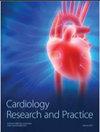miR-197 Participates in Lipopolysaccharide-Induced Cardiomyocyte Injury by Modulating SIRT1
IF 1.8
4区 医学
Q3 CARDIAC & CARDIOVASCULAR SYSTEMS
引用次数: 4
Abstract
Sepsis is a systemic inflammation and is capable of inducing myocarditis, which is a major leading cause of death in patients. Studies have found that miR-197 is correlated with the prognosis of patients with inflammatory heart disease, but its effect on sepsis-induced cardiomyocyte injury remains unclear. We treated H9c2 cells with lipopolysaccharide (LPS), then detected the cell viability via the cell counting kit-8 (CCK-8) assay and quantified miR-197 expression via quantitative real-time polymerase chain reaction (qRT-PCR). Then, we investigated the role of miR-197 in LPS-induced H9c2 cells by CCK-8 assay, flow cytometry, lactate dehydrogenase (LDH) measurement, enzyme-linked immunosorbent assay (ELISA), qRT-PCR, and western blot. Subsequently, silent information regulator 1 (SIRT1) was downregulated in H9c2 cells to explore its interaction with miR-197 under LPS induction. LPS induced miR-197 overexpression in H9c2 cells. LPS restrained viability, the expressions of B-cell lymphoma-2 (Bcl-2) and SIRT1, but promoted apoptosis, LDH release, and levels of interleukin-6 (IL-6), interleukin-1β (IL-1β), acetyl (AC)-p53, BCL2-associated X (Bax), and cleaved caspase-3 in H9c2 cells. miR-197 inhibition reversed the effects of LPS on H9c2 cells. The protective role of miR-197 downregulation in LPS-induced H9c2 cells was reversed by SIRT1 silencing. miR-197 contributed to LPS-induced cardiomyocyte injury by modulating SIRT1, which might be used as a molecular marker in the management of sepsis.miR-197通过调节SIRT1参与脂多糖诱导的心肌细胞损伤
败血症是一种全身性炎症,可诱发心肌炎,是患者死亡的主要原因。研究发现miR-197与炎症性心脏病患者的预后相关,但其在败血症引起的心肌细胞损伤中的作用尚不清楚。我们用脂多糖(LPS)处理H9c2细胞,然后通过细胞计数试剂盒-8 (CCK-8)检测细胞活力,通过定量实时聚合酶链反应(qRT-PCR)定量miR-197表达。然后,我们通过CCK-8测定、流式细胞术、乳酸脱氢酶(LDH)测定、酶联免疫吸附测定(ELISA)、qRT-PCR和western blot研究了miR-197在lps诱导的H9c2细胞中的作用。随后,沉默信息调控因子1 (SIRT1)在H9c2细胞中下调,探讨其在LPS诱导下与miR-197的相互作用。LPS诱导H9c2细胞中miR-197过表达。LPS抑制了H9c2细胞的活力、b细胞淋巴瘤-2 (Bcl-2)和SIRT1的表达,但促进了细胞凋亡、LDH释放以及白细胞介素-6 (IL-6)、白细胞介素-1β (IL-1β)、乙酰基(AC)-p53、bcl2相关X (Bax)和cleaved caspase-3的水平。miR-197抑制逆转了LPS对H9c2细胞的作用。miR-197下调对lps诱导的H9c2细胞的保护作用被SIRT1沉默逆转。miR-197通过调节SIRT1参与lps诱导的心肌细胞损伤,SIRT1可能被用作脓毒症治疗的分子标志物。
本文章由计算机程序翻译,如有差异,请以英文原文为准。
求助全文
约1分钟内获得全文
求助全文
来源期刊

Cardiology Research and Practice
Medicine-Cardiology and Cardiovascular Medicine
CiteScore
4.40
自引率
0.00%
发文量
64
审稿时长
13 weeks
期刊介绍:
Cardiology Research and Practice is a peer-reviewed, Open Access journal that publishes original research articles, review articles, and clinical studies that focus on the diagnosis and treatment of cardiovascular disease. The journal welcomes submissions related to systemic hypertension, arrhythmia, congestive heart failure, valvular heart disease, vascular disease, congenital heart disease, and cardiomyopathy.
 求助内容:
求助内容: 应助结果提醒方式:
应助结果提醒方式:


